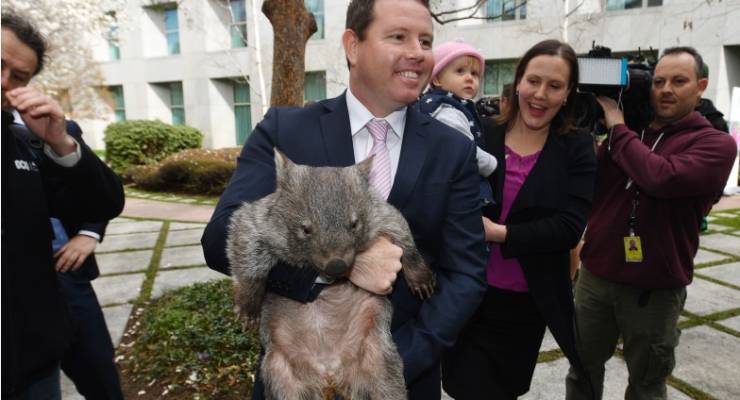
Question time is often more like feeding time at the zoo, but wild conduct from MPs aren’t the only animal antics in Parliament House.
Being in Canberra, Parliament House can fulfill tourists’ expectation that Australia is a country where kangaroos are spotted on the street. But while macropods have been papped loitering on the front lawns, the Department of Parliamentary Services said there had been no reports of them jumping the fence. I suppose that’s one less security concern.
Jumping back to the very beginning, horsing around in Parliament has a long history. At the opening of old Parliament House in 1927, thousands of horses pulled carriages, carried police, military and VIPs. Some even reportedly danced on the lawn. And while politicians today are divided over the welfare of jolly jumbucks in live exports, back in the day the labour of grazing sheep kept the lawns in top shape.
Fast forward ninety years and Parliament House is a place where many animals reside and thrive. An ABC report showed pesky possums perching on gardening sheds, drain pipes, tyres, and on top of air-conditioning units. But thanks to the grunt work from the Parliament House gardeners, these brush-tail bandits were built brand new homes — possum boxes in the taller trees of the gardens.
Pig-headed politicians aside, one of the more horrifying animal anecdotes Crikey heard was of a feral pig. The razorback came down from the bush, ripped up some of the surrounding gardens before being shot dead by a ranger.
From pests to productivity — Parliament House is abuzz with energy, but in March 2017 this took on new meaning. Three beehives were set up in the outer gardens under a licence with Department of Parliamentary Services. Beekeeper Cormac Farrell says safety and sustainability were paramount, with a full risk assessment and management plan, staff briefings, and ongoing monitoring to manage any sting from these tiny tenants. The bees are a sweet addition — a successful harvest of honey and wax have been used for special gifts for visitors, and to create artworks for kids in the Parliament childcare centre.
Crikey has confirmed a rumour that when Julia Gillard was Prime Minister she occasionally brought her adorable cavoodle Ruben into Parliament House. Whether she snuck him in or had official permission remains a mystery, but if you can’t bring your dog to work when you are the Prime Minister then honestly what’s the point? As for public pooches, guide dogs or other assistance animals are welcome in all public areas of Parliament House.
Turning to less domesticated animals, the annual international threatened species day is a gift to the press gallery camera operators and a reminder that you should never work with children or animals. Politicians from all parties pat and pose with native Australian fauna from snakes, to Tassie devils and koalas. While things can get messy they are still carefully managed — when Tanya Plibersek had a wee surprise from a wombat she told the media “I’ve had three children. I’ve been peed on before and from greater heights than this.”
Parliament House is a place of high hopes, but nobody flies as high as the dozen or birds that call it home. Species commonly recorded at Parliament Drive are the gang-gang cockatoo, black-faced cuckoo-shrike, common pigeon, superb fairy-wren, white-winged chough, Australian king-parrot, galah, long-billed corella, and the straw-necked ibis.
Within the Parliament House gardens, the big four battling for space are the Australian magpie, pied currawong, magpie-lark and the Australian raven. A lesson hard learnt is that you dine in the area outside the trough (Parliament cafeteria) at your peril, lest you be assaulted by magpies. Many a lunch has been lost to the beaks of these bold birds who with a fowl swoop will snatch a sandwich straight from your hands. At one stage a fake hawk was installed to ward off the black and white snipers.
A Parliament House employee told Crikey one lunch time they spotted a magpie lying on the ground in the senate courtyard. They presumed it was dead. Turns out it was in a food coma after gorging on the plagues of bogong moths that swarm Parliament House in the spring.
Senate estimates have discussed the moth issue over the years. Parliament is on the flight path, plus its position on the hill and bright lights act as a migrating moth magnet. Measures to curb the enthusiasm of the bogongs include mesh screens, dimmed lights, and poison, though the latter was considered too lethal after poisoning some of Parliament’s feathered friends. Attempts to abate aside, Parliament House cleaners spend spring hours vacuuming critter corpses off the carpet in what many refer to as the worst time of the year.
A 1988 parliamentary paper stated “New Parliament House will remain a wonderful beacon to attract the spring migrations of bogong moths for the next 200 years”. If ever there was a simile for the burn out of political life, then it is like moths to a flame — or moths to Parliament House.







If we left governing and legislation to the avians it could hardly be worse.
At least they would not be corrupt.
Greedy, reckless and quarrelsome but honest.
“Pig-headed politicians aside, one of the more horrifying animal anecdotes Crikey heard was of a feral pig. The razorback came down from the bush, ripped up some of the surrounding gardens before being shot dead by a ranger.”
One less at the trough, but what criteria did the ranger use to identify the pig?